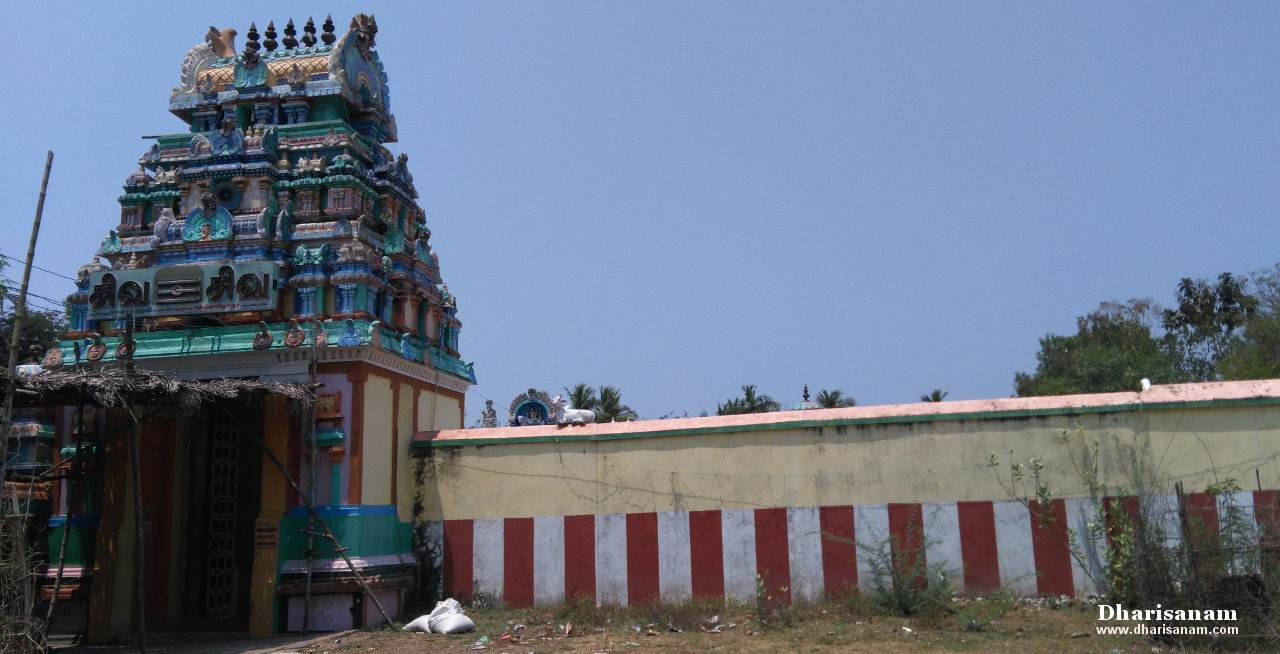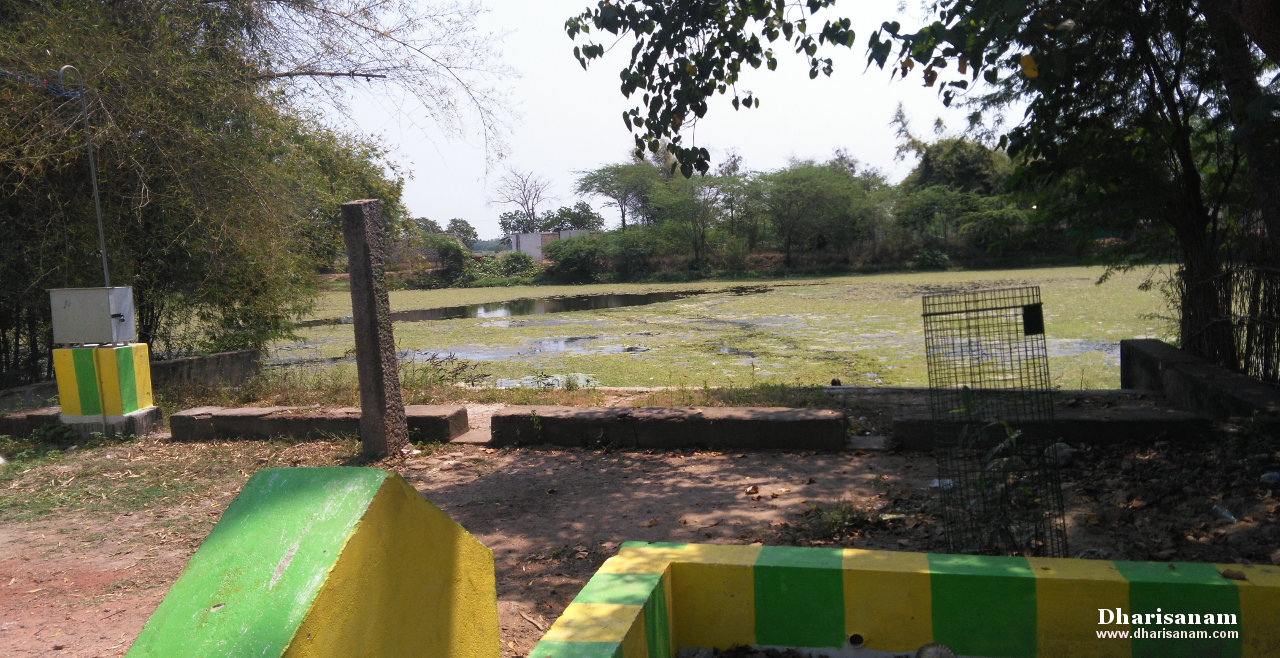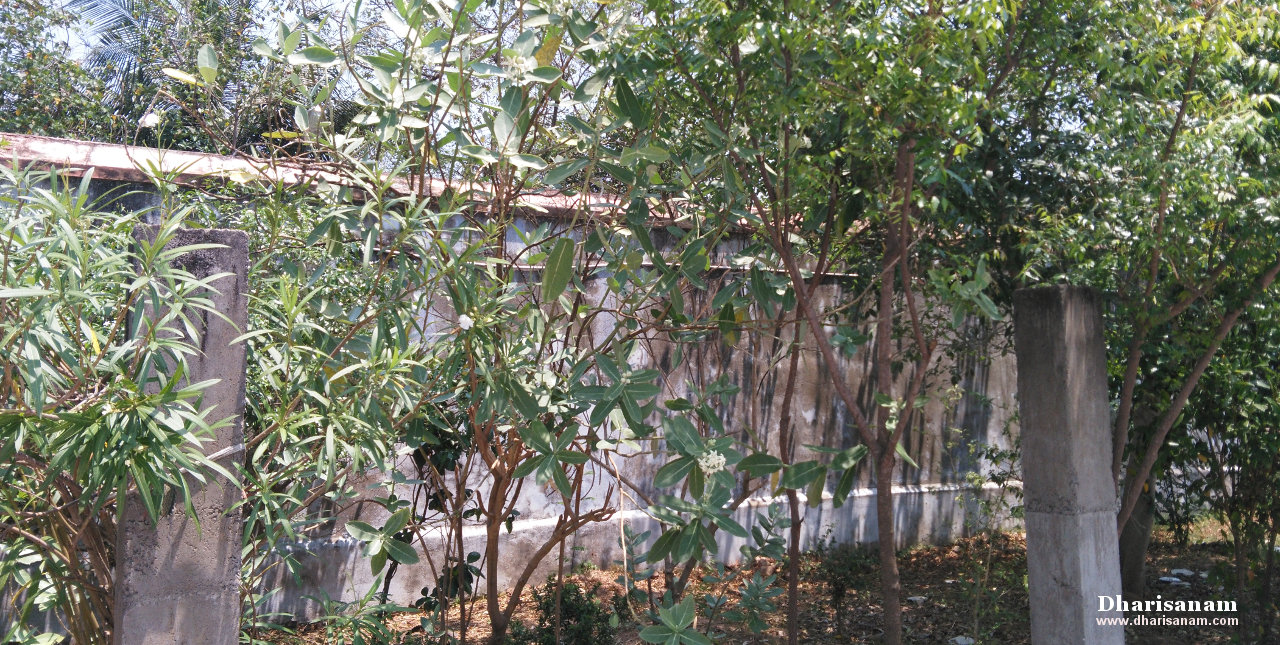Visited on: 30th March, 2018.
Location
Kanattumullur is situated at a distance of about 22 kms from Chidambaram on the Chidambaram – Kattumannarkoil - Omampuliyur route. It is very close to Muttam village. From Omampuliyur, this place is about 5 kms.
Other Paadal Petra Shiva Sthalams near this place are - Thiru Omampuliyur (3 kms), Thiru Kadampur, Thiru Naaraiyur, Erukkathampuliyur (Rajendrapatinam) and Thiru Kudalaiyatrur.
General Information
| Moolavar | Sri Pathanjali Nathar |
| Ambal | Sri Kol Valaikkai Ammai, Sri Kaanarkuzhali, Sri Ambujakshi |
| Theertham (Holy water) | Surya Theertham |
| Sthala Vriksham (Sacred Tree) | Vella Erukku Plant |
| Pathigam (Hymn) rendered by | Saint Sundaramurthy (Sundarar)-1 |
- This is one of the 276 Devara Paadal Petra Shiva Sthalams and 32nd Shiva Sthalam on the northern bank of the river Cauvery in Chozha Nadu (Vadakarai).
- Lord Shiva in this temple is a Swayambumurthi (self-manifested).
- This east facing temple has two corridors and its main tower (Rajagopuram) has 3-tiers.
- The last consecration ceremony (Maha Kumbabishekam) took place on 05.04.2012 and prior to that on 20.08.2000.
History of the Temple
This ancient temple is located on the northern bank of the river Kollidam.
The historical names of this place are Mathookavanam, Athishta Miruthika Kshetram and Thiru Kanattu Mullur.
There are some stone inscriptions in this temple which date back to the periods of Chola kings Vikrama, Rajendra and Rajendra-III.



Legend
It is believed that some sages from Dandakaranya visited this place to worship Lord Shiva. Lord Shiva created many lingams here so that the sages could worship him. In fact, the lord created so many lingams here that there was no space left to place one’s foot. The sand of this place is in itself considered very auspicious and devotees carry some of this sand with them. For this reason, this place gets the name “Athishta Miruthika Kshetram” (“Athishta” means luck and “miruth” means sand in Tamil).
Adhisheshan (the serpent on which Lord Mahavishnu rests) conveyed his desire to watch Lord Shiva’s cosmic dance. Lord Mahavishnu advised him to take birth on earth as sage Pathanjali and worship Lord Shiva. When Adhisheshan followed Lord Mahavishjhu’s advice, he was blessed with the darshan of Lord Shiva’s cosmic dance in Chidambaram.
On the advice of Nandhi, sage Pathanjali visited this place and worshiped the lord. He wanted to see the dance again. Lord Shiva appeared as Sri Pathanjaleeswarar and performed his cosmic dance again.
Lord Shiva is praised here as “Sri Pathanjali Nathar” because sage Pathanjali worshiped him here.


Saint Sundaramurthy came to Kanattumullur after worshiping the lord at Thiru Mannippatikkarai (Iluppaipattu). He was unable to proceed further to this temple as the entire place was filled with Shiva lingams that resembled thorny bushes. He did not want to step on them and decided to render his pathigam from the outskirts itself. Hence this place is also called “Kaal Naattam Mul Oor” (which can roughly be translated as “the village where you cannot place your foot”). This was later changed to Kanattumullur and Kanattam Puliyur.
It is believed that Lord Suryan created a tank here and worshiped Lord Shiva. Lord Indra also worshiped the lord in this place.
Deities in the temple
Other than the shrines of Lord Shiva and Goddess Parvathy, shrines and idols of Niruthi Vinayakar, Murugan with his consorts, Natarajar, Nalvar, Suryan, Chandran, Bairavar, Kasi Viswanathar with Visalakshi, Gajalakshmi and Saneeswarar can be seen in the main hall and the corridors. There is no Navagraham here.
There is a group of idols which depicts few Nagars (Serpents), Nagakanni, Lord Krishna and a Shivalingam.
In the sanctum sanctorum, on either side of the lord, idols of Lord Vinayakar and Dandapani can be seen.
In the “koshtam” (place surrounding the sanctum sanctorum), idols of Narthana Vinayakar, Dakshinamurthy, Mahavishnu, Brahma, Durgai and Chandikeswarar can be seen.
There is a separate shrine for Sage Pathanjali in the corridor.









Salient Features
It is believed that Lord Suryan (Sun) worships Lord Shiva of this temple by directing his rays on the lingam every year for three days in the Tamil month of Chithirai (Apr-May).
Lord Dakshinamurthy here is seen without his usual “Kallala” tree (banyan tree).
Goddess Valli is seen wearing an hanging ear ornament called “Pambadam” (or “Thandatti”), an ornament usually worn by elderly women.
It is believed that there are six Theerthams associated with this temple. They are – Surya theertham, Kama theertham, Vishnu theertham, Parvathy theertham, Indra theertham and Ganathipa theertham. Of these, Surya theertham is right in front of this temple and the others are located around the temple.
Greatness of this temple
Devotees pray to Goddess Kol Valaikkai Ammai to seek boons for early marriage and child birth (“Santhana Prapthi”).
Devotees believe that worshipping Lord Shiva here will bless them with wealth and prosperity.
Devotees worship Sage Pathanjali here to seek relief from the adverse effects of serpent planets.
Important Festivals
Some of the important festivals celebrated in this temple are –
Vaikasi Visakam in the Tamil month of Vaikasi (May-June),
Vinayakar Chaturthi in the Tamil month of Aavani (Aug-Sept),
Navarathri in the Tamil month of Purattasi (Sept-Oct),
Annabishekam in the Tamil month of Aippasi (Oct–Nov),
Thiru Karthikai in the Tamil month of Karthikai (Nov-Dec),
Thiruvadhirai in the Tamil month of Markazhi (Dec-Jan) and
Shivrathri in the Tamil month of Masi (Feb-Mar).
Pradosham is also observed regularly.
Temple Timings
From 07.00 AM to 09.00 AM and from 06.00 PM to 07.30 PM.
Temple Address
Sri Pathanjali Nathar Temple,
Kanattumullur (Kanattam puliyur),
Muttam Post,
Kattumannarkoil Taluk,
Cuddalore District,
Tamil Nadu – 608306.
Tele: +91-4144 208508, 208091.
Contact person: Sri V.Jayachandran at +91 – 97903 33377, 9894684269.
The temple priest Sri Sekar Gurukkal can be contacted at +91 -94862 20284.




Pathigam (Hymn) with English transliteration
Saint Sundaramurthy Nayanar visited this temple and sang this Pathigam.
Devotees visiting this temple should make it a practice to recite this Pathigam.
வள்வாய மதிமிளிரும் வளர்சடையி னானை
மறையவனை வாய்மொழியை வானவர்தங் கோனைப்
புள்வாயைக் கீண்டுலகம் விழுங்கியுமிழ்ந் தானைப்
பொன்னிறத்தின் முப்புரிநூல் நான்முகத்தி னானை
முள்வாய மடல்தழுவி முடத்தாழை ஈன்று
மொட்டலர்ந்து விரைநாறும் முருகுவிரி பொழில்சூழ்
கள்வாய கருங்குவளை கண்வளருங் கழனிக்
கானாட்டு முள்ளூரிற் கண்டுதொழு தேனே.
“Vaḷvāya mathimiḷirum vaḷarsaṭaiyi ṉāṉai
maṟaiyavaṉai vāymozhiyai vāṉavarthaṅ kōṉaip
puḷvāyaik kīṇṭulakam vizhuṅkiyumizhn thāṉaip
poṉṉiṟaththiṉ muppurinūl nāṉmukaththi ṉāṉai
muḷvāya maṭalthazhuvi muṭaththāzhai īṉtṟu
moṭṭalarnthu viraināṟum murukuviri pozhilchūzh
kaḷvāya karuṅkuvaḷai kaṇvaḷaruṅ kazhaṉik
kāṉāṭṭu muḷḷūriṟ kaṇṭuthozhu thēṉē”.
ஒருமேக முகிலாகி ஒத்துலகந் தானாய்
ஊர்வனவும் நிற்பனவும் ஊழிகளுந் தானாய்ப்
பொருமேவு கடலாகிப் பூதங்கள் ஐந்தாய்ப்
புனைந்தவனைப் புண்ணியனைப் புரிசடையி னானைத்
திருமேவு செல்வத்தார் தீமூன்றும் வளர்த்த
திருத்தக்க அந்தணர்கள் ஓதுநக ரெங்குங்
கருமேதி செந்தாம ரைமேயுங் கழனிக்
கானாட்டு முள்ளூரிற் கண்டுதொழு தேனே.
“Orumēka mukilāki oththulakan thāṉāy
ūrvaṉavum niṟpaṉavum ūzhikaḷun thāṉāyp
porumēvu kaṭalākip pūthaṅkaḷ ainthāyp
puṉainthavaṉaip puṇṇiyaṉaip purisaṭaiyi ṉāṉaith
thirumēvu selvaththār thīmūṉtṟum vaḷarththa
thiruththakka anthaṇarkaḷ ōthunaka reṅkuṅ
karumēthi senthāma raimēyuṅ kazhaṉik
kāṉāṭṭu muḷḷūriṟ kaṇṭuthozhu thēṉē”.
இரும்புயர்ந்த மூவிலைய சூலத்தி னானை
இறையவனை மறையவனை எண்குணத்தி னானைச்
சுரும்புயர்ந்த கொன்றையொடு தூமதியஞ் சூடுஞ்
சடையானை விடையானைச் சோதியெனுஞ் சுடரை
அரும்புயர்ந்த அரவிந்தத் தணிமலர்க ளேறி
அன்னங்கள் விளையாடும் அகன்றுறையின் அருகே
கரும்புயர்ந்து பெருஞ்செந்நெல் நெருங்கிவிளை கழனிக்
கானாட்டு முள்ளூரிற் கண்டுதொழு தேனே.
“Irumpuyarntha mūvilaiya chūlaththi ṉāṉai
iṟaiyavaṉai maṟaiyavaṉai eṇkuṇaththi ṉāṉaich
churumpuyarntha koṉtṟaiyoṭu thūmathiyañ chūṭuñ
chaṭaiyāṉai viṭaiyāṉaich chōthiyeṉuñ chuṭarai
arumpuyarntha aravinthath thaṇimalarka ḷēṟi
aṉṉaṅkaḷ viḷaiyāṭum akaṉtṟuṟaiyiṉ arukē
karumpuyarnthu peruñchennel neruṅkiviḷai kazhaṉik
kāṉāṭṭu muḷḷūriṟ kaṇṭuthozhu thēṉē”.
பூளைபுனை கொன்றையொடு புரிசடையி னானைப்
புனலாகி அனலாகிப் பூதங்கள் ஐந்தாய்
நாளைஇன்று நெருநலாய் ஆகாய மாகி
ஞாயிறாய் மதியமாய் நின்றவெம் பரனைப்
பாளைபடு பைங்கமுகின் சூழலிளந் தெங்கின்
படுமதஞ்செய் கொழுந்தேறல் வாய்மடுத்துப் பருகிக்
காளைவண்டு பாடமயில் ஆலும்வளர் சோலைக்
கானாட்டு முள்ளூரிற் கண்டுதொழு தேனே.
“Pūḷaipuṉai koṉtṟaiyoṭu purisaṭaiyi ṉāṉaip
puṉalāki aṉalākip pūthaṅkaḷ ainthāy
nāḷai'iṉtṟu nerunalāy ākāya māki
ñāyiṟāy mathiyamāy niṉtṟavem paraṉaip
pāḷaipaṭu paiṅkamukiṉ chūzhaliḷan theṅkiṉ
paṭumathañchey kozhunthēṟal vāymaṭuththup parukik
kāḷaivaṇṭu pāṭamayil ālumvaḷar chōlaik
kāṉāṭṭu muḷḷūriṟ kaṇṭuthozhu thēṉē”.
செருக்குவாய்ப் பைங்கண்வெள் ளரவரையி னானைத்
தேவர்கள்சூ ளாமணியைச் செங்கண்விடை யானை
முருக்குவாய் மலரொக்குந் திருமேனி யானை
முன்னிலையாய் முழுதுலக மாயபெரு மானை
இருக்குவாய் அந்தணர்கள் எழுபிறப்பு ளெங்கும்
வேள்வியிருந் திருநிதியம் வழங்குநக ரெங்கும்
கருக்குவாய்ப் பெண்ணையொடு தெங்குமலி சோலைக்
கானாட்டு முள்ளூரிற் கண்டுதொழு தேனே.
“Serukkuvāyp paiṅkaṇveḷ ḷaravaraiyi ṉāṉaith
thēvarkaḷchū ḷāmaṇiyaich cheṅkaṇviṭai yāṉai
murukkuvāy malarokkun thirumēṉi yāṉai
muṉṉilaiyāy muzhuthulaka māyaperu māṉai
irukkuvāy anthaṇarkaḷ ezhupiṟappu ḷeṅkum
vēḷviyirun thirunithiyam vazhaṅkunaka reṅkum
karukkuvāyp peṇṇaiyoṭu theṅkumali chōlaik
kāṉāṭṭu muḷḷūriṟ kaṇṭuthozhu thēṉē”.
விடையரவக் கொடியேந்தும் விண்ணவர்தங் கோனை
வெள்ளத்து மாலவனும் வேதமுத லானும்
அடியிணையுந் திருமுடியுங் காணவரி தாய
சங்கரனைத் தத்துவனைத் தையல்மட வார்கள்
உடையவிழக் குழலவிழக் கோதைகுடைந் தாடக்
குங்குமங்கள் உந்திவரு கொள்ளிடத்தின் கரைமேற்
கடைகள்விடு வார்குவளை களைவாருங் கழனிக்
கானாட்டு முள்ளூரிற் கண்டுதொழு தேனே.
“Viṭaiyaravak koṭiyēnthum viṇṇavarthaṅ kōṉai
veḷḷaththu mālavaṉum vēthamutha lāṉum
aṭiyiṇaiyun thirumuṭiyuṅ kāṇavari thāya
saṅkaraṉaith thaththuvaṉaith thaiyalmaṭa vārkaḷ
uṭaiyavizhak kuzhalavizhak kōthaikuṭain thāṭak
kuṅkumaṅkaḷ unthivaru koḷḷiṭaththiṉ karaimēṟ
kaṭaikaḷviṭu vārkuvaḷai kaḷaivāruṅ kazhaṉik
kāṉāṭṭu muḷḷūriṟ kaṇṭuthozhu thēṉē”.
அருமணியை முத்தினை ஆனஞ்சும் ஆடும்
அமரர்கள்தம் பெருமானை அருமறையின் பொருளைத்
திருமணியைத் தீங்கரும்பின் ஊறலிருந் தேனைத்
தெரிவரிய மாமணியைத் திகழ்தருசெம் பொன்னைக்
குருமணிகள் கொழித்திழிந்து சுழித்திழியுந் திரைவாய்க்
கோல்வளையார் குடைந்தாடுங் கொள்ளிடத்தின் கரைமேற்
கருமணிகள் போல்நீலம் மலர்கின்ற கழனிக்
கானாட்டு முள்ளூரிற் கண்டுதொழு தேனே.
“Arumaṇiyai muththiṉai āṉañchum āṭum
amararkaḷtham perumāṉai arumaṟaiyiṉ poruḷaith
thirumaṇiyaith thīṅkarumpiṉ ūṟalirun thēṉaith
therivariya māmaṇiyaith thikazhtharusem poṉṉaik
kurumaṇikaḷ kozhiththizhinthu suzhiththizhiyun thiraivāyk
kōlvaḷaiyār kuṭainthāṭuṅ koḷḷiṭaththiṉ karaimēṟ
karumaṇikaḷ pōlnīlam malarkiṉtṟa kazhaṉik
kāṉāṭṭu muḷḷūriṟ kaṇṭuthozhu thēṉē”.
இழைதழுவு வெண்ணூலும் மேவுதிரு மார்பின்
ஈசன்றன் எண்டோ ள்கள் வீசியெரி யாடக்
குழைதழுவு திருக்காதிற் கோளரவ மசைத்துக்
கோவணங்கொள் குழகனைக் குளிர்சடையி னானைத்
தழைதழுவு தண்ணிறத்த செந்நெலதன் அயலே
தடந்தரள மென்கரும்பின் தாழ்கிடங்கி னருகே
கழைதழுவித் தேன்றொடுக்குங் கழனிசூழ் பழனக்
கானாட்டு முள்ளூரிற் கண்டுதொழு தேனே.
“Izhaithazhuvu veṇṇūlum mēvuthiru mārpiṉ
īsaṉtṟaṉ eṇṭō ḷkaḷ vīsiyeri yāṭak
kuzhaithazhuvu thirukkāthiṟ kōḷarava masaiththuk
kōvaṇaṅkoḷ kuzhakaṉaik kuḷirsaṭaiyi ṉāṉaith
thazhaithazhuvu thaṇṇiṟaththa sennelathaṉ ayalē
thaṭantharaḷa meṉkarumpiṉ thāzhkiṭaṅki ṉarukē
kazhaithazhuvith thēṉtṟoṭukkuṅ kazhaṉichūzh pazhaṉak
kāṉāṭṭu muḷḷūriṟ kaṇṭuthozhu thēṉē”.
குனிவினிய கதிர்மதியஞ் சூடுசடை யானைக்
குண்டலஞ்சேர் காதவனை வண்டினங்கள் பாடப்
பனியுதிருஞ் சடையானைப் பால்வெண்ணீற் றானைப்
பலவுருவுந் தன்னுருவே ஆயபெரு மானைத்
துனிவினிய தூயமொழித் தொண்டைவாய் நல்லார்
தூநீலங் கண்வளருஞ் சூழ்கிடங்கி னருகே
கனிவினிய கதலிவனந் தழுவுபொழிற் சோலைக்
கானாட்டு முள்ளூரிற் கண்டுதொழு தேனே.
“Kuṉiviṉiya kathirmathiyañ chūṭusaṭai yāṉaik
kuṇṭalañchēr kāthavaṉai vaṇṭiṉaṅkaḷ pāṭap
paṉiyuthiruñ chaṭaiyāṉaip pālveṇṇīt ṟāṉaip
palavuruvun thaṉṉuruvē āyaperu māṉaith
thuṉiviṉiya thūyamozhith thoṇṭaivāy nallār
thūnīlaṅ kaṇvaḷaruñ chūzhkiṭaṅki ṉarukē
kaṉiviṉiya kathalivaṉan thazhuvupozhiṟ chōlaik
kāṉāṭṭu muḷḷūriṟ kaṇṭuthozhu thēṉē”.
தேவியம்பொன் மலைக்கோமன் றன்பாவை யாகத்
தனதுருவம் ஒருபாகஞ் சேர்த்துவித்த பெருமான்
மேவியவெந் நரகத்தில் அழுந்தாமை நமக்கு
மெய்ந்நெறியைத் தான்காட்டும் வேதமுத லானைத்
தூவிவாய் நாரையொடு குருகுபாய்ந் தார்ப்பத்
துறைக்கெண்டை மிளிர்ந்துகயல் துள்ளிவிளை யாடக்
காவிவாய் வண்டுபல பண்செய்யுங் கழனிக்
கானாட்டு முள்ளூரிற் கண்டுதொழு தேனே.
“Thēviyampoṉ malaikkōmaṉ tṟaṉpāvai yākath
thaṉathuruvam orupākañ sērththuviththa perumāṉ
mēviyaven narakaththil azhunthāmai namakku
meynneṟiyaith thāṉkāṭṭum vēthamutha lāṉaith
thūvivāy nāraiyoṭu kurukupāyn thārppath
thuṟaikkeṇṭai miḷirnthukayal thuḷḷiviḷai yāṭak
kāvivāy vaṇṭupala paṇseyyuṅ kazhaṉik
kāṉāṭṭu muḷḷūriṟ kaṇṭuthozhu thēṉē”.
திரையினார் கடல்சூழ்ந்த தென்னிலங்கைக் கோனைச்
செற்றவனைச் செஞ்சடைமேல் வெண்மதியி னானைக்
கரையினார் புனல்தழுவு கொள்ளிடத்தின் கரைமேற்
கானாட்டு முள்ளூரிற் கண்டுகழல் தொழுது
உரையினார் மதயானை நாவலா ரூரன்
உரிமையால் உரைசெய்த ஒண்டமிழ்கள் வல்லார்
வரையினார் வகைஞாலம் ஆண்டவர்க்குந் தாம்போய்
வானவர்க்குந் தலைவராய் நிற்பரவர் தாமே.
“Thiraiyiṉār kaṭalchūzhntha theṉṉilaṅkaik kōṉaich
chetṟavaṉaich cheñchaṭaimēl veṇmathiyi ṉāṉaik
karaiyiṉār puṉalthazhuvu koḷḷiṭaththiṉ karaimēṟ
kāṉāṭṭu muḷḷūriṟ kaṇṭukazhal thozhuthu
uraiyiṉār mathayāṉai nāvalā rūraṉ
urimaiyāl uraiseytha oṇṭhamizhkaḷ vallār
varaiyiṉār vakaiñālam āṇṭavarkkun thāmpōy
vāṉavarkkun thalaivarāy niṟparavar thāmē”.







